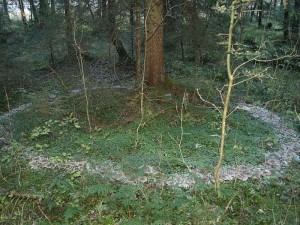which is quite a coincidence as we were discussing this very topic at the weekend, except at that point I didn’t realise what they were. If you see a circle (or circles) of lush grass or indeed dead grass, then that is a fairy ring.
These are caused by fungus growing underground – later in the year you might see the fruiting bodies, aka mushrooms. If the grass is much greener and thicker that’s because the mycelium (the underground bit equivalent to plant roots) is adding nutrients, if it is dead grass then the the fungus is damaging the plant roots. Each fairy ring is caused by a single fungus.
The rings are thought to start from a single spore that grows outwards until it reaches a certain size (around a metre) after which they run out of nutrients in the centre and start to form a ring, with nutrients passed around the ring to the point where they are needed. If the ring hits an obstacle such as stone the bit by the stone will die and the rest will grow around it. However, if it hits a larger obstacle such as a path it will stop growing and die. There were many reasons postulated for this, but it was discovered that the fungi are very polar and grow in one direction only, therefore if the is blocked they can’t grow anywhere else and therefore run out of nutrients. If they run into another fairy ring they compete with each other and both die! Despite this there are records of some fairy rings that are over 100 years old. According to one article I read there is a fairy ring in France that’s 600m in diameter and thought to be over 700 years old.
Fairy rings are also found in woodlands where they are known as tethered fairy rings as the mycelium are attached to the tree roots. The fungi gives the tree water and mineral nutrients such as nitrogen that it extracts from the soil and in return gets sugars from the tree. The mycelium are often seen in borders where they look like a mould on things like bark chips. In fact, fungi are one of natures great recyclers, being one of the few organisms that can break down lignin from trees due to the complex enzymes they contain.
Although fungi are very diverse; there are around 5 million species worldwide compared with 400,000 plant species, in the UK there are about 60 species that form fairy rings.
As can be gathered from the name fairy ring, there is a lot of folklore associated worldwide with these mushroom manifestations, worryingly enough the legends seem to have continued into the twentieth century. I won’t go into details, but suffice it to say it involves fairies and dancing and having to do all sorts of superstitious things such as running round the ring nine times with your cap on back to front if you find yourself in one of these rings.



